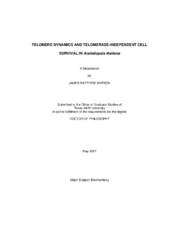| dc.description.abstract | Telomeres are the nucleoprotein structures that protect the ends of eukaryotic
chromosomes from being recognized as DNA double-strand breaks. Telomeres are
recognized by the ribonucleoprotein telomerase, a reverse transcriptase that catalyzes
addition of G-rich telomeric DNA repeats to the 3’ overhang of the telomere. The action
of telomerase allows cells to overcome the end-replication problem defined by the
inability of conventional DNA polymerases to fully replicate the end of the chromosome.
Telomeric DNA tracts are maintained in a species-specific size range primarily through
the competition between telomerase and the end-replication problem. In many
organisms, recombinational activities can function at telomeres outside of the wild type
range, in some cases resulting in telomerase-independent telomere maintenance.
Telomere rapid deletion (TRD) can dramatically shorten elongated telomeres.
Elongation of telomeres below the normal range in the absence of telomerase is known
as alternative lengthening of telomeres (ALT).
Here we demonstrate that telomeres in Arabidopsis thaliana are also subjected to these
recombinational activities. Elongated telomeres in ku70 mutants are shortened by TRD.
In contrast to other organisms, TRD functions on telomeres of wild type length. TRD
produces extra-chromosomal telomeric circles, which can serve as substrates for ALT.
In Arabidopsis, ALT may require the byproducts of TRD, as telomerase mutants with extremely short telomeres are unable to maintain telomeric repeats by recombination
and instead secure their genome through an unknown mechanism. Finally, we follow
the fate of cells with telomere-to-telomere fusions. Fusions are not propagated to viable
progeny. We propose that a G1 checkpoint dependent upon the checkpoint protein
ATM arrests cells following the break of a single telomere fusion. We design reporter
constructs to follow the fate of individual cells with telomere fusions, and present initial
characterization of their expression. We find no evidence for the propagation of
telomere fusions in somatic cells, though later generation mutants will provide a better
test of this hypothesis. This work begins the study of the fate of cells with telomere
fusions in Arabidopsis. Furthermore, it sets the foundation for studying recombinational
shortening and elongation of telomeres in Arabidopsis and the effects of these
processes on telomere length regulation. | en |


